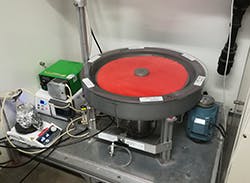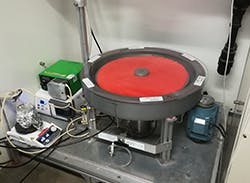New Chemical Reactor Works Like A Vinyl Record Player
Engineers behind the spinning mesh disc reactor win funding to continue development.
The Spinning Mesh Disc Reactor (SMDR), developed by University of Bath chemical engineers Dr. Emma Emanuelsson-Patterson and Dr. Parimala Shivaprasad, reportedly creates chemicals and APIs – active pharmaceutical ingredients used to create all sorts of medicines – by reacting chemicals with enzymes on a spinning cloth-covered plate, like a vinyl record. The pair's company, SMDR Ltd, won funding from Innovate UK to commercialize the reactor and market it to pharmaceutical companies following its 12-year development.
The SMDR creates chemicals by imitating the action of a record player: an enzyme applied to a woolen cloth disc is spun on a turntable, where it reacts with a chemical substrate, creating the desired compound or API. The Emanuelsson research group has shown that using a cloth disc protects the enzymes from denaturing or shearing, which renders them unusable, and allows optimal contact between the enzyme catalyst and the substrate, which ensures fast reactions. This means the catalyst cloth disc can be used for far longer, making the process cheaper and more sustainable than traditional reactors, according to the university.
"The basic principle of the SMDR is using the centrifugal forces generated by rotation to create a very consistent and repeatable reaction. Chemical engineers strive to enhance this kind of 'mass transfer' as it produces faster reactions, and in our case more chemicals or APIs," says Emanuelsson-Patterson.
Shivaprasad adds, "One of the main advantages of the SMDR essentially works a little bit like a jukebox that can switch between records. Using the catalyst cloth mesh discs, which can be swapped easily and quickly, means we can apply a range of different reagents or catalysts rapidly, creating a wide range of chemicals or APIs."
Explaining the need for better efficiency, Emanuelsson-Patterson says, "Reagents and enzymes are expensive and also very sensitive to how they're handled, particularly with regard to shearing (or tearing) forces. Using the mesh disc and harnessing centrifugal forces means we've significantly reduced these risks, giving more potential to safely reuse them. This has benefits in efficiency, cost and sustainability."
The disc design also creates potential for improving the efficiency of chemical production, according to the university – catalysts can be switched in and out quickly, creating flexibility and scope for batch production. One exciting challenge the team will investigate is how the SMDR could run several different reactions, using multiple catalysts at the same time.
Shivaprasad was a part of the three-month ICURe program to carry out the market analysis for the SMDR. The main objective was to identify the current challenges in chemical manufacturing and if the SMDR had the potential to alleviate these challenges to improve processing efficiency in chemical industries.
For more information, visit: www.bath.ac.uk

